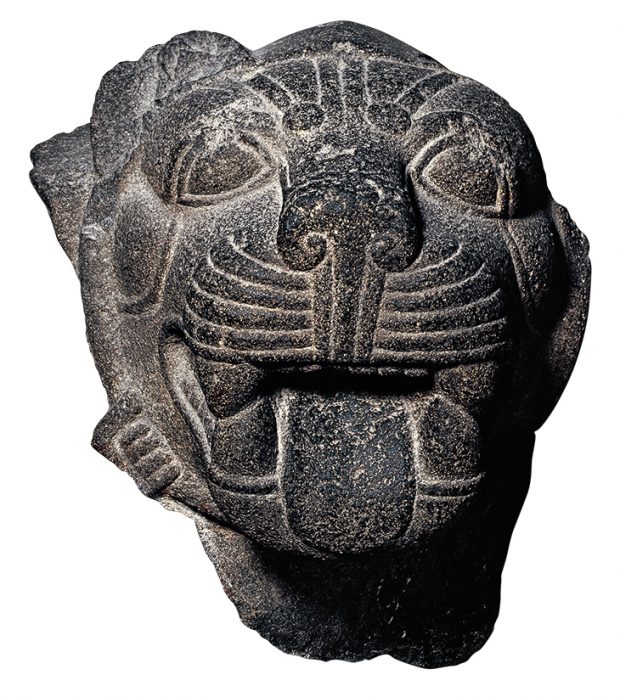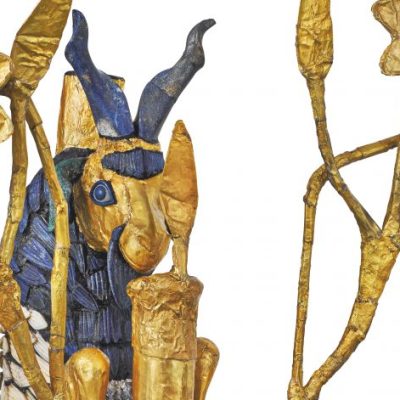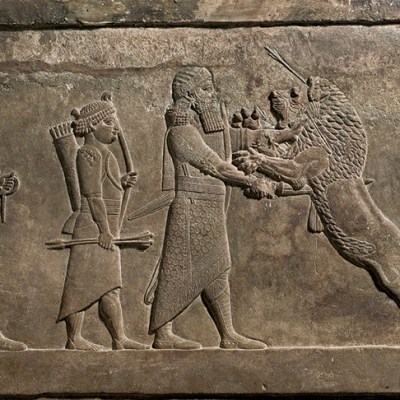In around 1200 BC, the Near East was dominated by a group of interconnected complex states – scholars refer to them as the ‘Great Powers’ Club’. Over the course of about 400 years, from 1500 to 1100 BC, this club variously included Egypt, Hatti (the land of the Hittites of Anatolia), Babylonia, Assyria, and Mitanni. In each state, kings and nobles led lavish lifestyles in their palaces and sent expensive gifts to one another; this created a far-flung international trade in luxury goods, feeding the palace economies. A shared identity developed among the palace elites too; they knew each other’s fashions, literature, and even spoke Akkadian as their lingua franca. But there was an unexpected side effect: each state became interconnected, the stability of one dependent on the others.
Then came the Bronze Age collapse. After 1200 BC, a combination of environmental disasters, from ‘earthquake storms’ to droughts, led to famine and mass migrations. Over decades, the inter-palace trade in luxury goods dried up, economies crashed, and elites were cut off from one another. Cities fell amid the chaos, some due to invasions, others perhaps due to popular uprisings. These events redrew the eastern Mediterranean and Near Eastern world’s political map: the territories controlled by Babylon and Assyria shrunk to their cores; Egypt lost its empire and crumbled into political disunity; Greece entered a dark age; meanwhile, the Hittite empire, stretching from western Anatolia into Syria, completely collapsed, leaving a void. The world of interconnected palace systems ceased to exist.
Seated goddess with a child (c. 14th–13th century BC), Hittite, central Anatolia, Turkey. Metropolitan Museum of Art, New York

An exhibition opening this month at the Louvre, ‘Forgotten Kingdoms: From the Hittite Empire to the Arameans’ (2 May–12 August), will explore these dramatic events from the point of view of the Hittites; it will take visitors through the rise of their empire in Syria and Anatolia, their conflicts and eventual treaty with ancient Egypt, and the world-altering collapse at the end of the Bronze Age, which left a power vacuum in south-eastern Anatolia and Syria. But more intriguingly, it will take visitors through what happened next: the emergence and short-lived independence of the Neo-Hittite and Aramean kingdoms. Though they may not be as well-known as the ancient Egyptians, Assyrians, or Persians, and are not often the subject of major exhibitions, it fell to these kingdoms to make their way in a shattered world. Some would say they lived in interesting times. Others might call it a dark age.
When the Hittite empire collapsed, territory once under Hittite control returned to local populations. Left to their own devices, small kingdoms formed, some established by members of the fallen Hittite regime. Initially, these kingdoms may have been loosely controlled by the Great King of Carchemish in Syria – a regional capital in the days of empire – who was a tangential member of the Hittite royal family. Ultimately though, each kingdom became independent, forming alliances only when necessary. It is these 15 kingdoms in south-eastern Anatolia and northern Syria – those that attempted to continue Hittite traditions – that are today known as Neo-Hittite; these primarily spoke the Indo-European language Luwian and carved Luwian hieroglyphs on their monuments.
Many people today are aware of the Hittites because of references to them in the Bible; however, the connection between the biblical Hittites and the groups identified by archaeologists is not straightforward. Scholars have divided the biblical Hittites into two categories: a small tribe living in southern Palestine before the arrival of the Israelites, unconnected to the Hittite kingdom of Anatolia; and the people of the Iron Age kingdoms in Syria and south-eastern Anatolia that we today call Neo-Hittite. Interestingly, the great Hittite civilisation that existed in Anatolia and Syria in the Late Bronze Age – rediscovered only in the 19th century – is not mentioned in the Bible at all.
Head of a lion, 9th century BC, Neo-Hittite, Carchemish in south-eastern Anatolia, Turkey. British Museum, London. © The Trustees of the British Museum

While the Neo-Hittite kingdoms were emerging, a previously nomadic tribal people decided to settle down and found their own kingdoms across Syria and in northern Mesopotamia: these were the Arameans, speakers of the Semitic language Aramaic. First evidenced in an Assyrian inscription of the 12th century BC, the Arameans’ tribal origin is reflected in the names of the states they established: each began with the word Bit meaning ‘House of’, connecting each with a particular family line. The Arameans established their kingdoms in key locations along trade routes (though some cities they controlled had already existed for many centuries, including Damascus).
One of the curious aspects of this phase in Near Eastern history is the interplay between innovation and tradition. Before the collapse, the Near East relied on scribes trained in Akkadian cuneiform for international correspondence; it was key to diplomatic and trade relations. To learn such a complex writing system, however, each scribe had to undergo years of training and memorise hundreds of symbols. Few had access to this life-changing opportunity, and even fewer after the collapse, when centres of scribal training – usually palace-sponsored – either closed or became reduced in number. Although the Neo-Hittite states of Syria continued to use Luwian hieroglyphs on their monuments, it is in this period that we find the beginnings of a world-altering development: the spread of alphabetic writing.
The Arameans didn’t invent alphabetic script – this honour goes to the Phoenicians of the Lebanese coast – but they did popularise it. Adopting the Phoenician alphabet in around 1100 BC, within a few centuries, the Arameans had transformed it into their own flowing cursive script: Aramaic. And afterwards, due to the success of Aramean cities in the trade network, their language and its script spread widely. Any smart trader learned Aramaic as a second language, and its script was much quicker to pick up than the Assyrians’ cuneiform.
Funerary stele of Si Gabbor, priest of the moon god, early 7th century BC, Neo-Hittite, Neirab, Syria. Photo: © Musée du Louvre, dist. RMN-Grand Palais/Christian Larrieu

Over time, Aramaic inscriptions came to be used for all sorts of purposes, from royal inscriptions to religious and funerary texts. Aramaic words on some funerary stele, for example, claim that no silver or copper was placed in the grave – an attempt to deter grave robbers. Such an inscription can be seen in ‘Forgotten Kingdoms’ on a stele from Neirab in Syria, dated to the 7th century BC, which depicts the priest of the moon god, Si Gabbor, happily sitting before a table, drinking from a cup, while a servant swats away flies. Later, when the Assyrians deported Arameans across the Near East, they took their language with them, spreading it further. Aramaic came to be the dominant written script in the region – it was even an official language of empire under the Persians – and was itself adapted into Hebrew and Arabic.
Just as the alphabetic script spread after the Bronze Age collapse, so did the use of iron, which replaced bronze as the utilitarian metal of choice. This change began in around the 10th century BC, marking the start of the Near Eastern Iron Age. Why this happened is still debated. One theory is that it probably wasn’t motivated by necessity, technology, or access to materials, but by the thinking of the people after the collapse; they looked at available resources with new eyes, and saw opportunities. The collapse provided a chance for local rulers to reduce their reliance on the international trade network that supplied the copper and tin needed to make bronze – a network that, since the collapse, had revealed its weaknesses, for it had left them dependent on others for one of their key metals. By controlling the extraction and manufacture of iron locally, the region’s various rulers ensured a constant, uninterrupted supply of a metal that met their everyday needs. This process of widening the usage of iron seems to have initially begun in modern Israel and Jordan, but soon spread into Syria and northern Mesopotamia.
Along with these innovations, after the collapse, Bronze Age cultural traditions continued and evolved. In religion, the Arameans adopted aspects of beliefs already held in the regions they settled; they worshipped the storm and fertility god Hadad, and the fertility and war goddess Atar’ate. The Neo-Hittite kingdoms similarly continued the traditional beliefs of the Hittites as if nothing had changed. On one stele in the Louvre exhibition, dated to around 900 BC and found at Til Barsib in Syria, the storm god, shown in profile holding a thunderbolt, is given his Hittite name, Tarhunda.
Newly founded cities, both under the Neo-Hittites and the Arameans, copied the urban layouts of earlier centuries; each city’s main focus remained a citadel, separating the palace area from the rest of the city. The kingdoms also imported the Hittite tradition of decorating gateways and major public streets with orthostats – free-standing slabs of sculpted stone. Traditionally, orthostats played an important role in a city’s public processions and ceremonies. During the early Iron Age, however, as time passed, orthostats came to be placed against important buildings, such as palaces and temples, and their carved scenes increasingly reflected the city’s nobility and court ceremonies, perhaps as a form of propaganda and legitimation. After all, new kings need to justify themselves.
The Hittite artistic tradition – a fusion of Egyptian, Levantine, Mesopotamian and even Aegean influences – also continued. In the Louvre exhibition, this can be seen in the basalt head of a lion from Carchemish, dated to the ninth century BC and perhaps an echo of the famous lion gate at the Hittite capital of Hattusa; and in the eighth-century-BC funerary stele of Tarhunpiyas, probably from ancient Gurgum in south-eastern Anatolia, depicting a mother and son in careful detail, her hands gently supporting him as he stands on her lap, each with prominent, large eyes. A relief depicting a deer hunt, made for King Maradash of the Neo-Hittite kingdom of Milid (modern Malatya in eastern Anatolia) in the 9th century BC, mixes influences from Mesopotamia, Syria, and the Hittites. This reflects the wider, ongoing fusion of cultures that occurred throughout this phase in Near Eastern history; with a world in flux, over time, what was Aramean or Neo-Hittite became blurred.
Funerary stele of Si Gabbor, priest of the moon god, early 7th century BC, Neo-Hittite, Neirab, Syria. Musée du Louvre, Paris

Perhaps the best known examples of Syrian art from this period were discovered at Tell Halaf (ancient Guzana), in north-east Syria; this major city was founded in the 11th century BC by the Arameans as capital of its own city state, Bit-Bahiani. Tell Halaf is one of the better known archaeological sites from this phase of Near Eastern history, mainly because of the eventful life of the orthostats and sculptures discovered there – some of which are on display in ‘Forgotten Kingdoms’. The German diplomat Max von Oppenheim (1860–1946) discovered Tell Halaf in 1899 while planning the route of the new Baghdad Railway. Despite lacking official permission, he spent a few days excavating the archaeological mound, uncovering colossal sculptures that he subsequently reburied. Intrigued by what he’d seen, Oppenheim later returned with a team of experts (and permission), and excavated the site over various fieldwork seasons.
Oppenheim’s discoveries were spectacular. In an open area known as the Lower Plaza, a long bench lined the front wall of the Palace of Kapara, providing a place for people to gather and sit; the back of each seat once featured a small carved orthostat, adding up to about 240 in total, each about 0.6m in height. These presented a range of scenes: cultivation, trade, hunters, animals and fantastic beasts, nobles and winged sun discs, fighting and warfare. On one orthostat, a man is run down by a chariot. On another, a lion plays a lyre, while a donkey defecates, surrounded by an orchestra of other animals – perhaps a scene from a popular tale. Larger orthostats, each about 1.5m in height, were uncovered along the northern facade of the palace; these depict bullmen, winged solar discs, and an archer among the scenes – perhaps deities protecting the ruler within the palace. At the nearby Scorpion Gate, carved creatures – human-headed, with a bird’s body, wings and claws, and scorpion’s tail – protected the entrance to the palace’s Upper Plaza. Each work was executed using artistic styles derived from Hittite, Levantine, and Mesopotamian tradition.
After the First World War, Oppenheim brought many of his unearthed sculptures to Germany, but failed to sell them to the Berlin Museums. So, to display his finds, he bought an ex-factory building in Charlottenburg and transformed it into the Tell Halaf Museum. This opened in 1930, but was bombed in 1943, during an allied raid. The explosion reduced the ancient monuments to smithereens – among them was the famous funerary statue that Oppenheim referred to as his ‘Venus’. Nothing but fragments – around 27,000 in total – remained of the artefacts; that is, until the early 21st century, when the National Museums of Berlin began a project to painstakingly reconstruct them. Now complete, many of Tell Halaf’s masterpieces can once again be experienced in the round, soon in the Louvre, and ultimately on display in their permanent home at the Pergamon Museum, Berlin.
Funerary sculpture, 10th–9th century BC, Neo-Hittite, Tell Halaf, north-eastern Syria. Vorderasiatisches Museum, Berlin

While the Neo-Hittites and Arameans lived through their interesting times, the might of Assyria grew in the background. And when the time came to halt the westward expansion of this aggressive state, the many kingdoms of Syria and the Levant formed coalitions, working together to ensure their future independence. All were defeated by 708 BC, swallowed into the Assyrian empire. This violent expansion may have absorbed the Neo-Hittite and Aramean kingdoms, but the invading Assyrians were injected with elements of their culture, from artistic traditions to language. You could say that the conquered kingdoms had the last laugh.
Preceded by the late Bronze Age civilisations and their dramatic demise, and followed by the first world empires, the Neo-Hittite and Aramean kingdoms flourished in a dynamic period of uncertainty. In this ‘dark age’, following one of the greatest societal collapses the world has known, they adopted and adapted traditions; developed new, more practical ways to express themselves; and identified opportunities by questioning past practices. Their world had collapsed, but they continued. They are a case study of how cultures survive, merge, and adapt in times of crisis. (In our current age of dramatic climate change, desperate migrations, huge wealth disparity, and political polarisation we may need to look to them for inspiration.)
By highlighting the Neo-Hittites and Arameans, the Louvre exhibition will draw attention to many of the ancient Syrian cities that produced the artworks displayed, underlining the historical richness of this war-ravaged country; you can’t look at these artefacts without wondering what has happened to these locations and the people there today. At the same time, the reconstructed shapes of the Tell Halaf sculptures from Berlin – among them a scorpion man, a relief of a lion, and the statue of a storm god – each held together like a shattered windscreen, are a reminder that cultural destruction can occur anywhere in the world, at any time. But the collection brought together for ‘Forgotten Kingdoms’ shows us that even in the worst situations, not all is lost. With perseverance and dedication, what was thought destroyed can be rebuilt.
‘Forgotten Kingdoms: From the Hittite Empire to the Arameans’ is at the Musée du Louvre, Paris, until 12 August.
From the May 2019 issue of Apollo. Preview and subscribe here.


